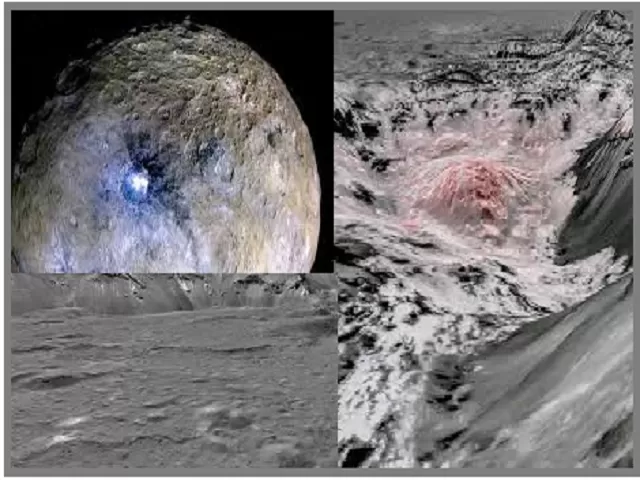There are five dwarf planets in our Solar System. NASA's Dawn Spacecraft scientists analysed and collected data that Ceres now has the status of an "ocean world". Therefore we can say that the latest data that has been collected from NASA's Dawn mission proves the most of the part of the planet has a vast repository of salty water hidden below its surface. That means it makes a possible home for life in the solar system.
The findings of NASA's Dawn mission have been published as a series of papers in the journals Nature Astronomy, Nature Communications, and Nature Geoscience.
About Ceres
Ceres is a dwarf planet and the largest object known in the asteroid belt between Mars and Jupiter. Our Solar System consists of five dwarf planets and the most famous is Pluto. The other dwarf planets are Eris, Makemake, Haumea, and Ceres.
Before going into detail let us first study the dwarf planet.
Dwarf planets are too small to be considered full-fledged planets but too large to fall into smaller categories. As we know that Pluto was considered as a planet since its discovery in 1930 but later was reclassified into the new "dwarf planet". To date, five dwarf planets have been found. The sixth claim for a dwarf planet is Hygiea which so far has been taken to be an asteroid. Although, astronomers estimate that there may be as many as 200 dwarf planets in the solar system and the Kuiper belt.
Let us tell you that European Space Organisation's SPHERE instrument observations at the Very Large Telescope (VLT), astronomers found that Hygiea may possibly a dwarf planet because it satisfied the four criteria to be a dwarf planet that is set up by the International Astronomical Union (IAU) for a celestial body. The IAU as of 2014 recognises five dwarf planets namely Ceres, Pluto, Eris, Haumea, and Makemake.
What are Asteroids and how are they formed?
Exploration of Ceres
Ceres is the earliest known and smallest of the present category of dwarf planets. In 1801, it was first discovered by a Sicilian astronomer Giuseppe Piazzi. He assumed that between Jupiter and Mars, Ceres was the missing planet. However, in 2006, it was clarified as a dwarf planet. It was based on the prediction that the gap between Mars and Jupiter contained a missing planet. It is only 590 miles or 950 km in diameter and has a mass of just 0.015 percent that of Earth. Ceres has a nearly round body.
About the Dawn Mission of NASA
The Dawn mission was launched in 2007 and visited Vesta and Ceres. Dawn arrived in 2011 at Vesta, the second-largest world in the main asteroid belt. The spacecraft became the primary or first to orbit a body within the region between Mars and Jupiter. In 2015, NASA's robotic Dawn mission arrived at Ceres to study its surface, composition, and history.
The mission has shown various interesting features on its surface, ranging from several bright spots to a 4-mile-high that is a 6.5-kilometer high mountain. In 2014, another mission, the European Space Agency's Herschel Space Observatory spotted the evidence of water vapour.
From the Dawn mission, the data helped scientists to learn how planets grow and differentiate and where and when life could have formed in the solar system.
Dwarf Planet Ceres is an Ocean World, What does this mean?
Ceres is the largest object in the Great Asteroid Belt and is a dwarf planet. Today, it has a new distinction that is the ocean world. The latest data from the Dawn Mission proves that the almost-planet has a vast repository of salty water hiding below its surface. That makes it possible to be a home for life in the solar system.
As per NASA "Ceres is a crucial piece of the ocean worlds puzzle." "With a crust that mixes ice, salts, rock-forming minerals, and other materials, Ceres looks to be a remnant “ocean world,” wearing the chemistry of its old ocean and records of the interaction on its surface.”
Scientist's observation from the Dawn mission is the presence of briny water under the surface of Ceres. Before the ending of the mission in October 2018, the spacecraft dipped to less than 35 km above the surface of the dwarf planet that is it was able to collect data in a higher resolution.
And so now by analysing the data, scientists determined that Ceres has a brine reservoir which is hundreds of miles wide which makes the dwarf planet "water-rich".
Therefore the team of the Researchers identified the two sources of salt deposits on Ceres: First, a slushy pool of brine just below the surface. It does not have geological heating but the impact that occurred Occator Crater liquified the water. After a few million years, the puddle cooled and the impact also created fractures that extend deep into the surface. Over time, that allowed more brine to seep up to the surface where it evaporated and left behind more salt.
Therefore, Ceres is an ocean world, at least to some degree as per the researchers. Ceres reservoir is of salty water and regional but it might be more expansive. Scientists further say that "Ceres can then be added to the rather short list of bodies for which we know the interior structure at high resolution, and the only ocean world to date (bar Earth).”
What are Near-Earth Objects (NEO)?
